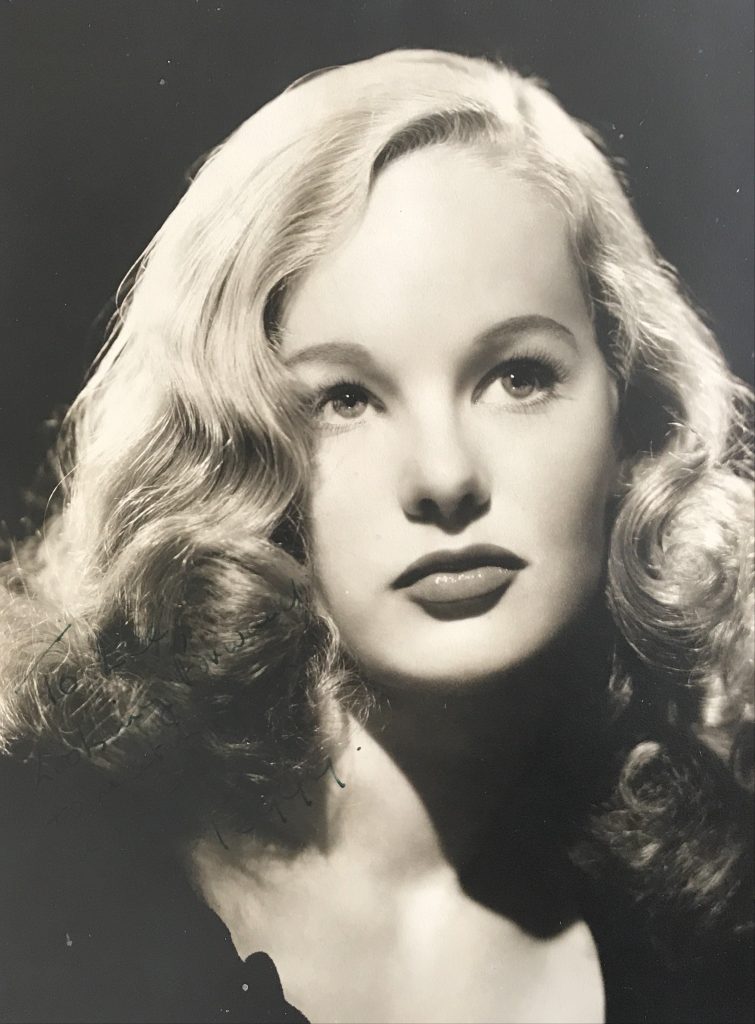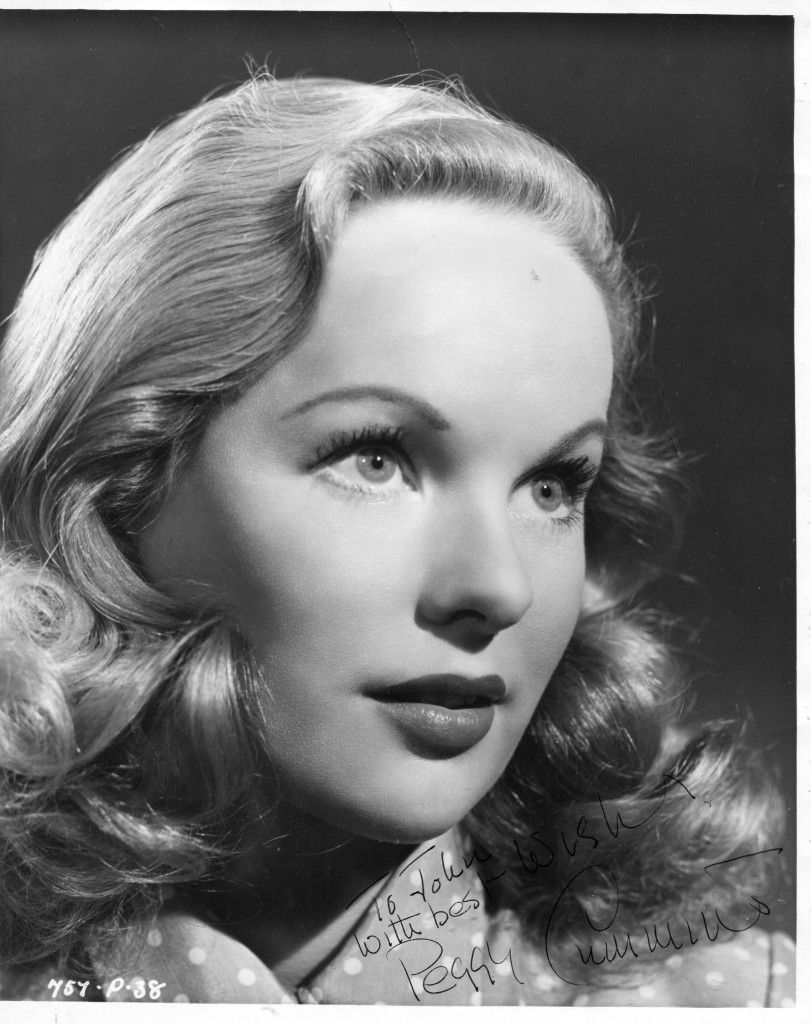


The times obituary in 2018.
One night in 2009, 83-year-old Peggy Cummins was on her way to the theatre when she was stopped in her tracks by a poster of a fruity young woman wearing a tight sweater and a beret, and with an icy look in her eyes. “I passed it and then I came back and thought, ‘Good heavens, I think that’s me,’ ” she said.
“I was going to the National Theatre, which is next door [to the British Film Institute’s cinema], and as I walked along the Thames I saw this giant poster for Gun Crazy.”
Gun Crazy was a low-budget thriller made in 1949, at the end of Cummins’s stint in Hollywood. During her time there she caused a stir by being linked romantically with Howard Hughes and John F Kennedy, but then she returned to England to make films with David Niven and Sean Connery before more or less disappearing into obscurity. Gun Crazy was unavailable for many years, but after Quentin Tarantino hailed it as a noir classic, it was rereleased in 2009 and is now recognised as a seminal work in the genre. Its story of two ill-fated, gun-toting bandits predated the Oscar-winning Bonnie and Clyde by nearly two decades. Faye Dunaway’s Bonnie even dressed like Cummins’s character in Gun Crazy, Annie Laurie Starr, wearing a beret, although in fairness both probably drew on photographs of the real Bonnie Parker.
Gun Crazy was shot on a shoestring in a quasi-documentary style, with a script written secretly by the blacklisted Dalton Trumbo, plus some improvised dialogue. Its style, tone and blend of sex and violence had a huge influence on later film-makers in Hollywood, and particularly in France and the directors of the Nouvelle Vague.
Cummins was used to playing “somebody’s daughter, and little parts”, and jumped at the chance to play the starring role of an amoral outlaw. The director Joseph H Lewis told her that she should act like “a dog in heat.
When she made the film, Cummins had no idea that it would one day be acknowledged as a masterpiece, while her bigger-budget films are largely forgotten.
Cummins was born Augusta Margaret Diane Fuller in Prestatyn in the Welsh county of Denbighshire (then in Flintshire), more or less by chance. Her parents lived in Dublin and were visiting Wales, and their return to Ireland was delayed by a combination of a storm and the impending arrival of their daughter.
She spent her early years in Dublin, where her father was a journalist and music teacher. Her mother, Margaret Tracy, was an actress, and Cummins began performing as a child. She worked in theatre and radio, made her West End debut in a children’s revue called Let’s Pretend on her 13th birthday, and began appearing in films during the Second World War. The legendary Hollywood producer Darryl F Zanuck was looking for someone to play the lead of the amoral young heroine in an adaptation of Kathleen Winsor’s romantic period novel Forever Amber. He saw Cummins and took the 19-year-old to Hollywood in a blaze of publicity.
“Fox made a big splash for me when I came over. I weighed 98 pounds and had an 18-inch waist,” she said. “I went to Zanuck’s party. All these people were there: Lubitsch, Tyrone Power, Joan Crawford. I said hello as though I knew them. It was awesome. They were stars. I was an actress.”
Forever Amber began shooting in California in 1946, but production was halted after a few weeks. According to Cummins, Zanuck thought she was “not sexy enough”. Speaking to the press, she said: “Say it was my lack of experience, say it was the colour of my eyes, say it was a lot of little things, but please don’t say I don’t have enough sex.” The film was recast with Linda Darnell, who was a few years older. Instead Cummins was given a lead role in a 1947 mystery called Moss Rose.
Her Hollywood fling with Kennedy came about long before he was president. The gossip columnist Sheilah Graham wrote: “News from the Hollywood love front. Peggy Cummins and Jack Kennedy are a surprise twosome around town during the 29-year-old congressman from Boston’s visit here.”
After playing Ronald Colman’s daughter in The Late George Apley in 1947, Cummins co-starred with Rex Harrison in Escape a year later. She then appeared in several other films that are not widely remembered. When she asked Fox to cancel her contract with three years still to go, no objection was raised.
It was then that she made Gun Crazy, before leaving Hollywood and returning to Britain, where she married Derek Dunnett, a businessman, in 1950. He died in 2000. She is survived by a son, David, and a daughter, Diana. While in Britain Cummins appeared in a wide range of films, including The Love Lottery, in which she starred alongside Niven in 1954; Hell Drivers, with Stanley Baker and a young Connery in 1957; and Night of the Demon in the same year.
She made a few films in the early 1960s and then retired from acting. She spent time between her flat in Mayfair and her 40-acre estate in Sussex. There, Cummins was involved in charity work and was chairwoman of the management committee of a holiday centre for children with disabilities.
After seeing the poster for Gun Crazy by chance that night, Cummins went to watch the film for the first time in 60 years. To her surprise, she also had a fanbase on social media. Her grandson informed her that she had her own hashtag on Instagram.
Cummins felt slightly ambivalent about the violence in Gun Crazy. “I don’t know whether I’m really proud of it or not,” she said. “It’s not what you want to show people.” On the other hand, she realised that the audience loved it. She subsequently attended screenings, festivals and events in the UK and the US. “I met Quentin Tarantino, who said he had seen Gun Crazy on DVD,” she said. “My grandchildren were very impressed.”
Peggy Cummins, actress, was born on December 18, 1925. She died of a stroke on December 29, 2017, aged 92.

